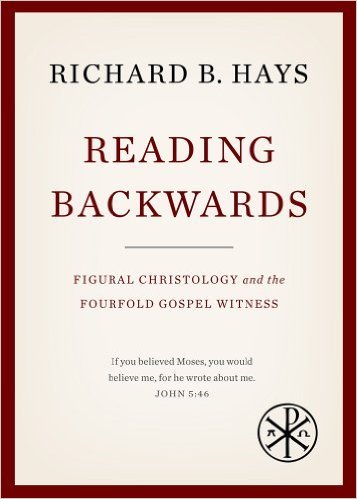What do you think?
Rate this book


177 pages, Hardcover
First published November 1, 2014
Richard Hays presents a high view of Jesus’ Messianic self-consciousness using narrative criticism of the four Gospels in Reading Backwards: Figural Christology and the Fourfold Gospel Witness. The book contains the published version of the Halsean Lectures delivered at Cambridge University in 2013.
For figural readings, Hays uses Erich Auerbach’s definition:
Figural interpretation establishes a connection between two events or persons in such a way that the first signifies not only itself but also the second, while the second involves or fulfills the first. The two poles of a figure are separated in time, but both, being real events or persons are within temporality. They are both contained in the flowing stream which is historical life, and only the comprehension, the intellectus spirituals, of the interdependence is a spiritual act.Figural interpretation is closely allied to typological interpretation, except that figural interpretation seems to work both ways. Figural interpretation aims higher than a simple prophetic-fulfillment scheme, for it is in the comprehension of mutual interactions between two events or persons that spiritual meaning is comprehended.
Hays uses figural interpretation to open new vistas on the four Gospels. Mark’s Gospel is Hays’ favorite because it presents Jesus’ Messianic consciousness in the allusive language of irony. Old Testament references abound in the Gospel without introductory formula specifying a particular prophet, but the reader familiar with prophetic texts catch the hint and understand Jesus consciously saw himself fulfilling these prophecies. Mark’s Gospel contains the most forthright disclosure of divine self-consciousness at the trial of Jesus (Mark 14:61-62), associated with the most abject descriptions of Jesus’ agony in Gethsemane (Mark 14:32-41) and abandonment at Golgotha (Mark 15:34). Mark’s Gospel ends in stunned silence before the empty tomb. The attentive reader is drawn into a new understanding of the redemptive narrative of the Old Testament culminating in Jesus’ disclosure of his hidden identity.
At the other extreme from Mark’s allusive Gospel is John’s Gospel, which discloses in the first verse the pre-existent deity of Jesus Christ before Creation . Between Mark’s Gospel and the Johannine witness lies the common thread of a high view of Jesus’ Messianic self-consciousness. That theme allows Hays to put the Synoptics and John into the same class of Old Testament interpreters. John’s Gospel has significantly fewer specific Scriptural citations, but the narrative captures the broader implications of the story of redemption through symbolic meanings. The test case for Hays is the reference to Moses:
For the law was given through Moses; grace and truth came through Jesus Christ. (John 1:16)
But do not think I will accuse you before the Father. Your accuser is Moses, on whom your hopes are set. If you believed Moses, you would believe me, for he wrote about me. But since you do not believe what he wrote, how are you going to believe what I say? (John 5:45-47)
These references raise the question for Hays about how John reinterpreted Torah. According to Hays’ enumeration, few references to Moses or Mosaic Law appear in the Gospel. This curious fact is offset by the symbols of Temple and Feast Days incorporated into the story of Jesus’ ministry. To cite just two, the cleansing of the Temple placed early in John’s Gospel transfers the site of God’s presence from the Temple to Jesus’ resurrected body (John 2:13-22). Another incident unique to John is Jesus’ self-identification with God as the one who provides food and drink during the Festival of Tabernacles (John 7:37=Lev 26:36). Also prominent is John’s appropriation of the symbol of the Passover Lamb to Jesus’ sacrificial death through the dating of the crucifixion on the Day of Preparation when the Lamb was slain, and the comparison between the piercing of Jesus’ side to unbroken bones of the Pascal lamb (John 19:31-37). Through the use of symbols like Temple and Feast Days, John’s Gospel places Jesus’ foreordained death and resurrection within the framework of an eternal plan of divine redemption.
Hays reads the Gospels in the context of first-century Jewish Messianic expectations prefigured in the Old Testament rather than the context of later extra-canonical sources like the Gospel of Thomas or the elusive Q source. Some scholars use the non-canonical context to argue that the historical Jesus was a moral teacher or apocalyptic miracle worker, but not a self-conscious divine Messiah. Hays makes the case for a figural reading of the Gospels by showing the varied and enriched depths of the divine character and self-understanding of Jesus required by his earliest followers. Granted, Hays does not claim that the self-understanding of Jesus in the Gospels is identical to the historical Jesus behind the text, but his reading aligns with the early high Christology of Paul and the early church shown by recent scholars like Larry Hurtado and Richard Bauckham.
Hays enhances both the Old Testament implied Messianic meaning and the effect of Old Testament Law, prophecy and Psalms on the self-understanding of Jesus. Prophetic allusions in the Gospels can sometimes be used to dispense with the Old Testament as a source book for fulfilled prophecies. Hays shows how the Gospels reinterpret the Old Testament with Jesus as the interpretive key that unlocks the Scriptures. Figural readings place greater emphasis on understanding the continuity between Jesus and the Old Testament, as well as highlighting the church’s growing and ongoing faith in Israel’s God who encounters us in the life, death and resurrection of Jesus.
The book is short (110 pages), non-technical and highly readable. Readers with a high view of Scripture will appreciate Hays’ assertion that Bible makes sense only on the assumption of God’s self-disclosure through the stories and words of Scripture. Footnotes and Indices guide the reader interested in further interaction with primary and secondary sources.